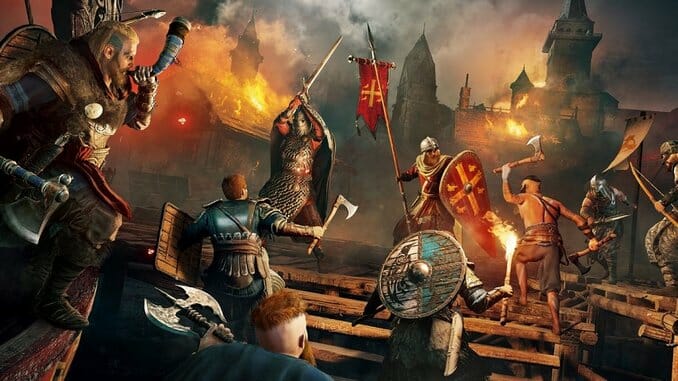Assassin’s Creed Valhalla Preview: A New Lease on Open World Games

The first thing I did in Assassin’s Creed Valhalla was pet a delightful dog. The second thing I did was depose the crown king of Mercia and install a puppet to carry out the will of my viking comrades. OK, so maybe there were a few steps in between the two. But over the course of my six hour preview with Assassin’s Creed Valhalla, I found that the game blends main and side quests together in a way that makes everything you do in the open world game feel connected together.
The game takes place during the viking invasions of England during the ninth century. You take control of the viking Eivor on their quest to settle in this new country. Coming out of having just played and reviewed Crusader Kings III, I was excited to see Ubisoft’s third-person take on a story I had played tens of times from a birds-eye view. For the preview, the main questline revolved around the previously mentioned deposition of King Burgred of Mercia. Eivor’s brother Sigurd was helping a neighboring clan install their own puppet king in the region in hopes of forming an alliance with them, which meant that Eivor was helping as well.
But first I had to actually get to the neighboring clan, and to do that I had to trek my way across a large stretch of England. There’s a tendency in open world games to have massive, sprawling maps that feel devoid of any actual content when you walk through them. Most games’ remedy to this conundrum is to simply have players not need to actually travel somewhere more than once by including a quick travel system. Assassin’s Creed Valhalla borrows from and builds off recent games like Red Dead Redemption 2 by making traveling a part of the gameplay experience via cinematic camera modes.
At any point, you can whistle for your horse and they’ll come running to you in an instant. If you’re near one of England’s many rivers, you can call for a viking dragon boat to take you to the next destination. In both cases, a cinematic camera mode allows you to take a back seat and enjoy the scenery while you go about your travels. I found myself nearly always taking the dragon boat; you can hear various songs and viking tales from the crew while they row you down the river. Outside the cinematic mode, taking control of the ship allows you to pick and choose when you want to raise your sail for higher speeds or have the crew gently row you. Either way, taking to the rivers to get to where you need to be is a relaxing break between the game’s quests and events.
That’s not to say that there’s nothing to do while traveling. While cruising down the river, Eivor would hear the cries of someone in need of help and I had to decide if I was in the mood for some heroic deeds. At one point, I heard a woman cry from within a tower that was being guarded by a dastardly knight. I crashed my ship into the shore, whipped out my axe and bashed the knight maybe twice before he ran off. Upon talking to the trapped woman, I discovered that her bondage was not involuntary, but rather of the kinky variety. With her captor—and lover—having fled, she attempted to drag me into her fetish play. Bondage isn’t really my thing, so I went back to the boat to the captive’s dismay.
Another time, I was listening to a crewmate tell a tall tale when Eivor hushed them. We were traveling through enemy territory, and the option to perform a raid came up. I started the raid, and the crew let out hearty cheers as Eivor blew a horn and the boat once again crashed into the shore. The organizing of these side events onto actual paths of travel made me seldom use the fast travel feature. I would do a few side quests on my way to the main one, and a few on the way back.